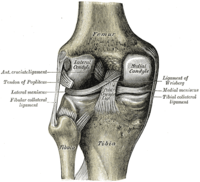
Photo from wikipedia
Background: Autologous chondrocyte implantation (ACI) and microfracture are established treatments for large, full-thickness cartilage defects, but there is still a need to expand the clinical and health economic knowledge of… Click to show full abstract
Background: Autologous chondrocyte implantation (ACI) and microfracture are established treatments for large, full-thickness cartilage defects, but there is still a need to expand the clinical and health economic knowledge of these procedures. Purpose: To confirm the noninferiority of ACI compared with microfracture. Study Design: Randomized controlled trial; Level of evidence, 2. Methods: Patients were randomized to be treated with matrix-associated ACI using spheroid technology (n = 52) or microfracture (n = 50). Both procedures followed standard methods. Patients were assessed by the Knee injury and Osteoarthritis Outcome Score (KOOS), MOCART (magnetic resonance observation of cartilage repair tissue) scoring system, Bern score, modified Lysholm score, International Cartilage Repair Society (ICRS) rating (histological and immunochemical scoring after rebiopsy 24 months after implantation), and International Knee Documentation Committee (IKDC) examination form. The main assessments were conducted 24 months after study treatment. Results: In the primary intention-to-treat analysis, the overall KOOS score for both ACI and microfracture yielded a statistically significant improvement relative to baseline. According to the between-group analysis, ACI passed the test of noninferiority compared with microfracture; thus, the primary goal of the study was achieved. The KOOS subscores yielded the same qualitative results as the overall KOOS score (ie, for each of these, noninferiority was demonstrated), and in 1 case (Activities of Daily Living subscore), the threshold for superiority was passed. The subgroup analyses did not yield any clear evidence of an association between treatment effect and any of the categories investigated (age, diagnosis, defect localization, sex). A histological analysis of biopsies from 16 patients (ACI: n = 9; microfracture: n = 7) suggested a better quality of repair in the patients treated with ACI. Conclusion: The efficacy of both ACI and microfracture was demonstrated with respect to both functional outcomes and morphological repair. The primary analysis confirmed the statistical hypothesis of the noninferiority of ACI, even for relatively small cartilage defects (1-4 cm2) treated in this study, the indication for which microfracture is generally accepted as the standard of care. ACI showed significant superiority in the KOOS subscores of Activities of Daily Living at 24 months and Knee-related Quality of Life at 12 months. Registration: NCT01222559 (ClinicalTrials.gov identifier).
Journal Title: Orthopaedic Journal of Sports Medicine
Year Published: 2019
Link to full text (if available)
Share on Social Media: Sign Up to like & get
recommendations!